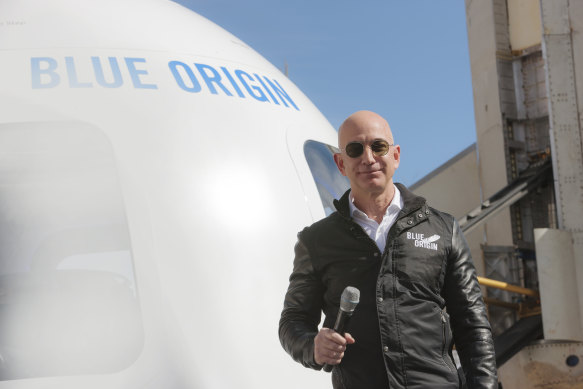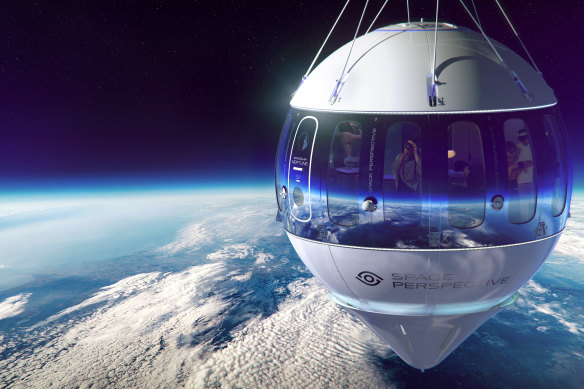Opinion
Space tourism? The Earth should be enough
Lee Tulloch
Travel columnistIsn’t our beautiful Earth good enough?
That’s the question I always ask when anyone mentions space tourism. Surely there’s still plenty to explore on our planet without feeling the need to blast yourself into space, wasting resources, creating space debris, possibly risking lives and potentially damaging the Earth you’re leaving?

Jeff Bezos, chief executive of Amazon, with his Blue Origin New Shepard rocket. Credit: Bloomberg
Couple that with the fact that the race to space tourism has been led by a trio of testosterone-fuelled billionaires trying to outdo each other in a frenzy to be first or most expensive, and the whole enterprise of shooting mega-rich tourists into space seems unsavoury rather than aspirational.
Still, in 2024 space tourism is, astoundingly, a reality, albeit for the very privileged few able to pay out-of-this-world prices.
American businessman Dennis Tito was the first paying space tourist back in 2001. He paid $US20 million ($31 million) to fly on a Russian spacecraft and spend seven days aboard the International Space Station.
In 2021, both Richard Branson’s Virgin Galactic and Amazon founder Jeff Bezos’s Blue Origin made their giant steps for mankind (or billionaires), completing suborbital flights with tourists onboard.
Suborbital flights are those where the spacecraft reaches outer space, but it can’t complete an orbital revolution or reach escape velocity, which is the minimum speed required to escape Earth’s gravitational influence.
Elon Musk’s SpaceX Space Dragon, developed with Houston-based space tourism company Axiom Space, goes further, literally. In 2022 SpaceX launched its first civilian flight, sending four astronauts on the world’s first all tourist orbit of the Earth. A berth on the recent flights have sold for reportedly $US55 million ($83.4 million).
The hot thing now is not to merely take a few spins around the Earth but to spend time on the International Space Station – accommodation and meals included of course, heralding the future advent of space hotels and Jetsons-style diners. Russian space agency Roscosmos is also doing a handy trade in sending billionaires to the space station.
Virgin Galactic claims there are 800 people on the waiting list for its £450,000 ($868,000) a person space flights, which have been paused until 2026 while it waits for a new line of spacecraft.
The airline’s motto is “turning the impossible into the inevitable” but until the prices leave the stratosphere, that doesn’t mean you or me will be seeing the “final frontier” anytime soon.
There is, however, a less pricey option. Edyta Teper, originally from Melbourne, is vice-president, global sales and trade of Space Perspective, which positions itself as the world’s first luxury, carbon-neutral spaceflight experience company. The Florida-based company’s vision is to make space travel accessible to everyone, not just multi-millionaires.
Bookings are now available for Spaceship Neptune, a pressurised capsule propelled by a massive space balloon, which will glide about 30 kilometres above the Earth, to the “edge of space”, where passengers can take in views of the Earth’s curve from premium seats.

Space Perspective plans to send tourists into space using a balloon.
According to Teper, the Space Perspective experience includes ’unprecedented views of our planet through the largest windows ever flown to space, a world-class meal and cocktail service, Wi-Fi, and a lavatory”.
For those who think a balloon, even one serving cocktails, sounds rather risky, the technologically advanced SpaceBalloon is trademarked and regulated by the US Federal Aviation Administration, following guidelines established by NASA.
Space Perspective is founded by industry pioneers and leading lights Jane Poynter and Taber MacCallum, whose team has been broadly instrumental in the development of every US human spacecraft for the past 40 years. The technology isn’t new. ″NASA has been doing this for 50 years,″ Teper says.
Passengers don’t need to be trained, which is an advantage. The pace is slow, aiming for a gentle, transformative experience as passengers see their world from another perspective. It’s known as the “overview effect”.
The cost of a trip? About $US125,000 ($190,000) a passenger, with a totally refundable deposit of $1000. The whole flight is about six hours, and costs as much as a top suite on an ultra-luxury 14-day cruise. According to Teper, there are plenty of willing astronauts.
The company had sold 1650 tickets when I spoke to her in December. Australians are adventurous – several have already booked seats for late 2024 flights. Travel Associates has reserved a capsule for eight people, she says.
If you’re really determined to have a space adventure but are short of funds, Space for Humanity has a Citizen Astronaut Program that sends a few select people to space for free.
Sign up for the Traveller Deals newsletter
Get exclusive travel deals delivered straight to your inbox. Sign up now.